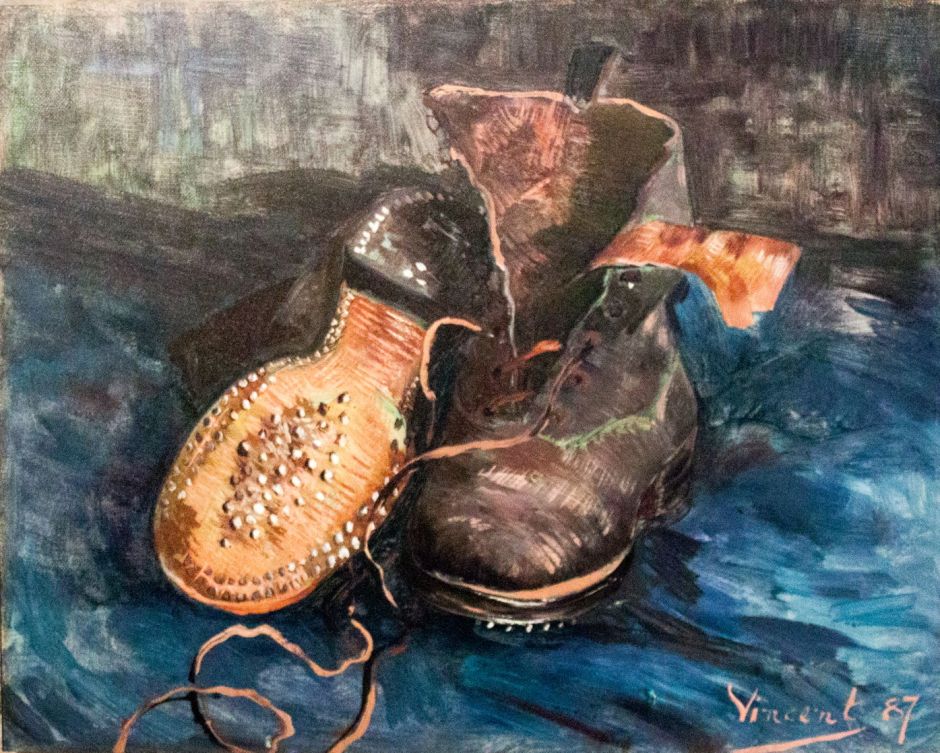Everyone looks at faces in paintings, and we all too seldom look at the feet at the other end of the body. Today and tomorrow I show paintings in which reading the feet is valuable for the additional information which they provide, sometimes even for the surprises they bring.
Until recently, most people travelled on foot. Extended families migrating across Europe, Roman legions expanding the empire, tinkers moving from village to village, and painters, all tended to walk. In March 1880, Vincent van Gogh walked nearly 50 miles (80 kilometres) to visit Jules Breton, Alfred Sisley earlier walked for several days through the Forest of Fontainebleau, and Paul Cézanne walked daily into the countryside around Aix-en-Provence to paint. Feet and what you wore on them were among each person’s defining properties.
Go back to ancient civilisations around the Mediterranean, and most people most of the time remained barefoot.

Exceptions to this were the gods, who were sufficiently divine as to wear sandals. Notable among those, as seen in this detail from Botticelli’s Primavera (c 1482), was Mercury. As the Messenger of the Gods, he is distinguished by his staff and special sandal-boots, often depicted with wings attached.

Lionel Royer’s painting of Vercingetorix Throwing down His Weapons at the feet of Julius Caesar from 1899 shows an interesting array of footwear from the Roman Empire. Caesar wears sandals without wings, and Vercingetorix some sort of riding boot. But the other barbarians are shown barefoot, compared against Roman soldiers who have combat sandals.
Footwear also plays an important part in some classical myths. Theseus’ father King Aegeus of Athens abandoned his mother Aethra, leaving only his sandals and sword hidden under a large rock.

When Theseus came of age, his first major task was to discover his father’s hidden sword and sandals, and set off in search of him. This is shown in Laurent de La Hyre’s Theseus And His Mother Aethra from 1635-36, although the king’s sandals appear more contemporary than classical.
When visible in a painting, footwear often tells you a great deal about the wearer.

The contrasting footwear worn by the two almost faceless women in Edgar Degas’ Waiting from about 1882 is a key part of his enigmatic pastel painting, and a reminder of the importance of the feet to those who dance.

In Henri Jules Jean Geoffroy’s Whoever Breaks the Glass Pays for It from 1881, a group of three young boys have broken a glass from a street café. The boy at the right is pointing down at the fragments of glass on the ground, and looking daggers at the other two; his clothing and lace-up boots are dirty and tattered. Those on the other boys are clean and more fashionable.

The cheeky ploughboy in Jules Bastien-Lepage’s Pas Mèche (Nothing Doing) from 1882 is on his way out to work in the fields. His face is grubby, his clothing frayed, patched, and dirty, and his hand-me-down boots caked in mud and laceless.

In Hans Andersen Brendekilde’s Worn Out from 1889, footwear tells an important part of the story. An old man has collapsed when working in the fields. A younger woman, his daughter perhaps, is giving him aid and shouting for all she’s worth to summon assistance. He was wearing wooden working clogs, as a poor farm labourer would; one of them has fallen off, an indication that he’s not going to get back up in a hurry. A century later, the English phrase popping your clogs was (coincidentally) in general use as an idiomatic euphemism for dying.

In much of the Russian Empire, the poor wore not clogs but felted boots to keep their feet as warm as possible during long and bitter winters. These are seen on pupils in Nikolay Bogdanov-Belsky’s painting Mental Arithmetic. In Public School of S. A. Rachinsky from 1895, showing a class in the village of Tatev in Smolensk province.
Having told you at the beginning of Vincent van Gogh’s long walks, it may come as no surprise that he made old, worn boots the subject of several still life paintings.

This image of his Pair of Shoes from early 1887 has been digitally reconstructed to reproduce its original colours better. What is most strange about these idiosyncratic still lifes is that the footwear was bought solely for the purpose of modelling. Van Gogh apparently bought boots from flea-markets, selecting them for signs of wear. This pair shows the many hobnails in their sole, and has marked wear at both toe and heel.
For those who could afford to wear fashionable clothing, outrageously impractical footwear was and remains a sign of their affluent disdain for working and walking.

Jean-Étienne Liotard’s A Lady in Turkish Costume with her Servant at the Hammam probably dates from the period he lived in Turkey. The hammam is more generally known as a Turkish Bath, and is a steam bath popular throughout the Muslim world. The distinctive shoes they are wearing are known as kabkabs from the sound they make when walking on stone, and were standard for ladies when in the hammam. They were also used to protect the feet from dust and dirt when outdoors.

Among Georges Clairin’s many paintings of ‘frou-frou’ is this Elegant Couple at the Coast, whose shoes certainly weren’t intended for standing on slippery rocks.

For all Marthe Bonnard’s humble origins, she developed a lasting fondness for white high-heeled shoes, which appear in many of Pierre Bonnard’s domestic scenes, including this of Marthe in the Dining Room from 1933.
Footwear has also become involved in sex and its symbolism, particularly during the twentieth century.

Egon Schiele uses bright colour to draw attention to this woman’s lips, nipples, and navel in his Crouching Woman with Green Headscarf from 1914, and further sexualises her with a pair of high-heeled boots. These are the only items of clothing she is wearing other than the headscarf.
Tomorrow we’ll take our shoes off and look at the reading of feet.

